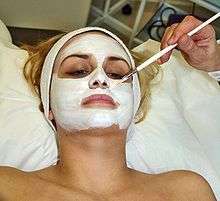Facial mask
The first facial mask was invented in England during the 18th century by Madame Rowley, the first “face glove” a mask which was beneficial for anyone who wanted to ‘bleach, purify and preserve the complexion’ of the skin. A sheet mask is a creamy or thick pasted mask applied to clean or smoothen the face. It often contains minerals, vitamins, and fruit extracts, such as cactus and cucumber. There are different kinds of masks for different purposes; some are deep cleansing for cleaning the pores. The perceived effect of a facial mask treatment can be revitalizing, rejuvenating or refreshing. Facial masks are most commonly used by women but are also used by men[1]. Although widely believed to provide tighter pores, increased skin clarity, and a reduction in facial skin wrinkles, masks have not been shown to be any more effective at accomplishing these things than a standard moisturizing lotion.[2]

Some masks are washed off with tepid water, others are peeled off by hand. Duration for wearing a mask depends on type of mask, but can be three minutes to 30 minutes, and sometimes the whole night.
Honey is a very popular mask because it smooths skin, and cleans pores. A popular home remedy includes a slice of cucumber on the eyes.[3] Some also use pickle juice.[4]
Facial masks should be selected according to skin type. Clay and mud masks suit oily skin; cream-based masks work best on dry skin types. Masks should be used only on cleansed skin for the best results. Firming masks should not be applied on the eye area because they can cause itching.[5]
See also
References
- Nilforoushzadeh, Mohammad Ali; Amirkhani, Mohammad Amir; Zarrintaj, Payam; Salehi Moghaddam, Abolfazl; Mehrabi, Tina; Alavi, Shiva; Mollapour Sisakht, Mahsa (October 2018). "Skin care and rejuvenation by cosmeceutical facial mask". Journal of Cosmetic Dermatology. 17 (5): 693–702. doi:10.1111/jocd.12730.
- Karen J. Carlson (1996). The Harvard Guide to Women's Health. Harvard University Press. p. 574. ISBN 978-0-674-36768-5.
- Joni Loughran (2002). Natural Skin Care. B. Jain Publishers. pp. 113–. ISBN 978-81-7021-995-8.
- Leiva, Courtney (2015-07-14). "I Tried Putting A Pickle Juice Toner On My Face". Bustle. Retrieved 2018-03-17.
- John Toedt; Darrell Koza; Kathleen Van Cleef-Toedt (2005). Chemical Composition of Everyday Products. Greenwood Publishing Group. pp. 31–. ISBN 978-0-313-32579-3.